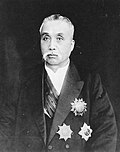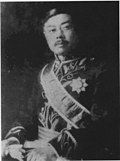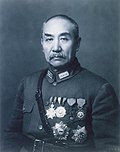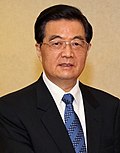List of presidents of the Republic (since 1912)
This is a list of the presidents of the Republic of China (ROC) (1912–present). The Republic of China president is called 總統 (Zǒngtǒng, "President"), and from 1912–1928, 大總統 (Dàzǒngtǒng, "Grand President").
Since 1949, the de facto territory of the ROC is reduced to Taiwan and its surrounding islands, the former previously ruled by Japan from 1895 to 1945, no longer governing mainland China. It continued to represent China in the United Nations until it was expelled on 25 October 1971 and diplomatically by the United States government until 1 January 1979. The President of the ROC is also known as the President of Taiwan due to the territory it governs.
All the names on this list follow the Oriental convention with the family name first and given name second.
Provisional Government: Tongmenghui Beiyang clique, etc.
Beiyang Government: Beiyang clique, etc. Progressive Party/Research Clique Communications Clique
Nationalist to Constitutional Government: Kuomintang Democratic Progressive Party
Presidents of the Provisional Government | ||||||||
| No. | Portrait | Name (Birth–Death) | Term of office | Political party | Vice President | Assembly (elected) | ||
|---|---|---|---|---|---|---|---|---|
| 1 |  | Sun Yat-sen 孫中山 (1866–1925) | 1 January 1912 | 10 March 1912 | Tongmenghui | Li Yuanhong (Nonpartisan) | Provisional (1911) | |
| 2 |  | Yuan Shikai 袁世凱 (1859–1916) | 10 March 1912 | 10 October 1913 | Beiyang clique | Li Yuanhong (Nonpartisan) | Provisional (1912) | |
Presidents of the Beiyang Government | ||||||||
| No. | Portrait | Name (Birth–Death) | Term of office | Political party | Vice President | Assembly (elected) | ||
| 1 |  | Yuan Shikai 袁世凱 (1859–1916) | 10 October 1913 | 6 June 1916 [note 1] [note 2] | Beiyang clique | Li Yuanhong (Progressive) | 1st (1913) | |
| 2 |  | Li Yuanhong 黎元洪 (1864–1928) | 7 June 1916 | 17 July 1917 [note 3] [note 4] | Progressive Party | Feng Guozhang (Zhili clique) | ||
| — |  | Feng Guozhang 馮國璋 (1859–1919) (acting) [note 5] | 17 July 1917 | 10 October 1918 | Zhili clique | Vacant | ||
| 3 |  | Xu Shichang 徐世昌 (1855–1939) | 10 October 1918 | 2 June 1922 [note 4] | Anhui clique | Vacant | 2nd (1918) | |
| — |  | Zhou Ziqi 周自齊 (1871–1923) (acting) [note 6] | 2 June 1922 | 11 June 1922 | Communications Clique | Vacant | ||
| (2) |  | Li Yuanhong 黎元洪 (1864–1928) | 11 June 1922 | 13 June 1923 [note 4] | Research Clique | Vacant | ||
| — |  | Gao Lingwei 高凌霨 (1868–1939) (acting) [note 7] | 14 June 1923 | 10 October 1923 | Zhili clique | Vacant | ||
| 4 |  | Cao Kun 曹錕 (1862–1938) | 10 October 1923 | 2 November 1924 [note 4] | Zhili clique | Vacant | 1923 | |
| — |  | Huang Fu 黃郛 (1883–1936) (acting) [note 6] | 2 November 1924 | 24 November 1924 | Nonpartisan | Vacant | ||
| 5 |  | Duan Qirui [note 8] 段祺瑞 (1865–1936) | 24 November 1924 | 20 April 1926 [note 4] | Anhui clique | Vacant | ||
| Vacant | ||||||||
| — |  | Hu Weide [note 9] 胡惟德 (1863–1933) (acting) [note 6] | 20 April 1926 | 13 May 1926 | Zhili clique | Vacant | ||
| — |  | Yan Huiqing (W.W. Yan) 顏惠慶 (1877–1950) (acting) [note 7] | 13 May 1926 | 22 June 1926 | Nonpartisan | Vacant | ||
| — |  | Du Xigui 杜錫珪 (1875–1933) (acting) [note 6] | 22 June 1926 | 1 October 1926 | Zhili clique | Vacant | ||
| — |  | V.K. Wellington Koo 顧維鈞 (1888–1985) (acting) [note 7] | 1 October 1926 | 17 June 1927 [note 10] | Nonpartisan | Vacant | ||
| 6 |  | Zhang Zuolin [note 11] 張作霖 (1875–1928) | 18 June 1927 | 4 June 1928 [note 12] | Fengtian clique | Vacant | ||
Chairmen of the Nationalist Government | ||||||||
| No. | Portrait | Name [note 13] (Birth–Death) | Term of office | Political party | Assembly (elected) | |||
| — |  | Tan Yankai 譚延闓 (1880–1930) | 7 February 1928 | 10 October 1928 | Kuomintang | 2nd National Congress of Kuomintang (4th plenum) | ||
| — |  | Chiang Kai-shek 蔣中正 (1887–1975) | 10 October 1928 | 15 December 1931 [note 10] | Kuomintang | 2nd National Congress of Kuomintang (5th plenum) | ||
| — |  | Lin Sen 林森 (1868–1943) | 15 December 1931 [note 14] | 1 August 1943 [note 2] | Kuomintang | |||
| 4th National Congress of Kuomintang (1st plenum) | ||||||||
| — |  | Chiang Kai-shek 蔣中正 (1887–1975) | 1 August 1943 [note 15] | 20 May 1948 | Kuomintang | |||
| 5th National Congress of Kuomintang (11th plenum) | ||||||||
Presidents after the 1947 Constitution | ||||||||
| No. | Portrait | Name (Birth–Death) | Term of office | Political party | Vice President | Term (elected) | ||
| 1 |  | Chiang Kai-shek 蔣中正 (1887–1975) | 20 May 1948 | 21 January 1949 [note 16] | Kuomintang | Li Zongren (Kuomintang) | 1 (1948) | |
| — |  | Li Zongren 李宗仁 (1890–1969) (acting) [note 5] | 21 January 1949 | 20 November 1949 | Kuomintang | Vacant | ||
| — |  | Yan Xishan 閻錫山 (1883–1960) (acting) [note 7] | 20 November 1949 | 1 March 1950 | Kuomintang | Vacant | ||
| (1) |  | Chiang Kai-shek 蔣中正 (1887–1975) | 1 March 1950 | 5 April 1975 [note 2] | Kuomintang | Li Zongren [note 17] (Kuomintang) | ||
| Vacant | ||||||||
| Chen Cheng [note 18] (Kuomintang) | 2 (1954) | |||||||
| 3 (1960) | ||||||||
| Vacant | ||||||||
| Yen Chia-kan (Kuomintang) | 4 (1966) | |||||||
| 5 (1972) | ||||||||
| 2 |  | Yen Chia-kan (C. K. Yen) 嚴家淦 (1905–1993) | 5 April 1975 | 20 May 1978 | Kuomintang | Vacant | ||
| 3 |  | Chiang Ching-kuo 蔣經國 (1910–1988) | 20 May 1978 | 13 January 1988 [note 2] | Kuomintang | Hsieh Tung-min (Kuomintang) | 6 (1978) | |
| Lee Teng-hui (Kuomintang) | 7 (1984) | |||||||
| 4 |  | Lee Teng-hui 李登輝 (1923–2020) | 13 January 1988 | 20 May 2000 | Kuomintang | Vacant | ||
| Lee Yuan-tsu (Kuomintang) | 8 (1990) | |||||||
| Lien Chan (KMT) | 9 (1996) | |||||||
| 5 |  | Chen Shui-bian 陳水扁 (born 1950) | 20 May 2000 | 20 May 2008 | Democratic Progressive | Annette Lu (DPP) | 10 (2000) | |
| 11 (2004) | ||||||||
| 6 |  | Ma Ying-jeou 馬英九 (born 1950) | 20 May 2008 | 20 May 2016 | Kuomintang | Vincent Siew (KMT) | 12 (2008) | |
| Wu Den-yih (KMT) | 13 (2012) | |||||||
| 7 |  | Tsai Ing-wen 蔡英文 (born 1956) | 20 May 2016 | 20 May 2024 | Democratic Progressive | Chen Chien-jen (Independent) | 14 (2016) | |
| William Lai (DPP) | 15 (2020) | |||||||
| 8 |  | Lai Ching-te 賴清德 (born 1959) | 20 May 2024 | Incumbent | Democratic Progressive | Hsiao Bi-khim (DPP) | 16 (2024) | |









